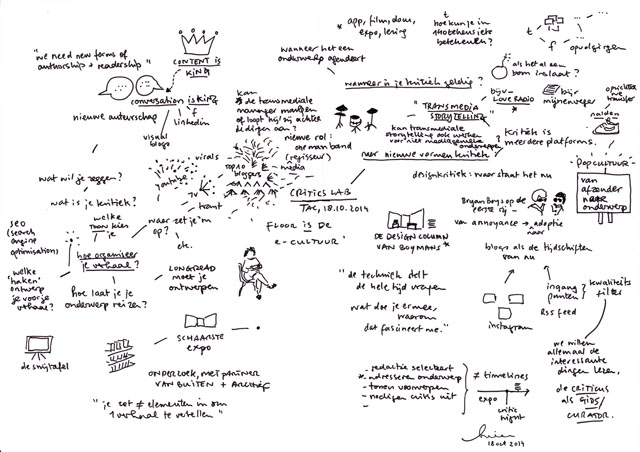Note on: building context
The Critics’ Lab of yesterday produced a couple of valuable memo’s about the conditions that design criticism operates within today. Here’s an incomplete list, freely drafted down:
– We need new forms of authorship and readership. Long reading is something you have to design. (Floor van Spanendonck)
– Writing in a language that is not your mother tongue can allow to be like an outsider of your own critique. Your mother tongue, though more comfortable, can produce “noise”, can be something you get stuck in. (Lucas Verwey).
– Context always corrects itself (Dingeman Kuilman, see also Works that Work)
– Can Transmedia storytelling also work for non media savvy issues?
– It seems that the changing media landscape forces us to take public relevance as a starting point for our critique; can all these media technologies be managed or do they manage us?
– We accept the falt surface (an image) as a basis to build our critique; everything is evaluated on the basis of images
– The value judgement (the rating culture) is becoming more important than the reflection
– Critique is moving away from the author, and towards the topic at hand
– Where do you position yourself, between the moving horizontal axis of visuality and the vertical axis of deep reading?
– A critique is valid when it stimulates you to define your own point of view, when its argumentation is legible, when it builds context, and when it simply helps us to see things in a new light
– How to be(come) an independent conscience for your professional field?
The masterclass I moderated, on building productive alliances, turned into an open conversation about what we consider to be “valuable”, and how to build an “economy” around that, in the etymological sense of the word:
1530s, “household management,” from Latin oeconomia (source of French économie, Spanish economia, German Ökonomie, etc.), from Greek oikonomia“household management, thrift,” from oikonomos “manager, steward,” from oikos “house, abode, dwelling” (cognate with Latin vicus “district,” vicinus“near;” Old English wic “dwelling, village;” see villa) + nomos “managing,” from nemein “manage” (see numismatic). Meaning “frugality, judicious use of resources” is from 1660s. The sense of “wealth and resources of a country” (short for political economy) is from 1650s.
